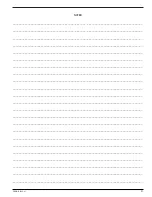
12
L4463 (
rev
.
c
)
8.2 Operating Instructions
The pump is operated by a two-button remote control
pendant. See Figure 8.
• Press and hold the green ON/ADV button to start
the pump and advance the wrench. The button must
remain pressed to advance the wrench.
• Release the green ON/ADV button to retract the
wrench. The pump will continue running.
• Press the red OFF button to stop the pump.
ON / ADV
OFF
• Press and hold to
start pump and
advance
wrench.
• Release to
retract
wrench.
• Press to stop
pump.
GREEN BUTTON
RED BUTTON
Figure 8: Starting and Stopping the Pump
8.3 Relieving Hydraulic Pressure
To fully relieve hydraulic pressure using the pendant:
• Press and hold the red OFF button while pressing
and releasing the green ON/ADV button several
times. See Figure 9.
• Verify that the hydraulic pressure gauge indicates
zero (0) psi/bar. Then, release the red OFF button.
• Repeat this sequence if any pressure remains
indicated on the gauge.
NOTICE
Sufficient air pressure must be present at the
pump air inlet connection to relieve hydraulic pressure
using the pendant.
If compressed air supply is disconnected or not
functioning, and trapped hydraulic pressure is present:
• Relieve hydraulic pressure
manually
by turning
the user-adjustable relief valve counter-clockwise
until pressure is relieved. Refer to Section 8.5 for
additional information.
• Verify that the hydraulic pressure gauge indicates
zero (0) psi/bar.
2.
While holding red button,
press and release green
button several times.
3.
Verify that hydraulic
pressure is completely
relieved.
0 psi/bar
ON / ADV
OFF
1.
Press and hold
red button.
▲
Figure 9: Relieving Hydraulic Pressure
8.4 Removing Air from Hydraulic System
When the torque wrench is first connected to the pump,
or after a different torque wrench is connected, air may
become trapped in the hoses and components.
To ensure smooth and safe operation, remove air by
cycling the torque wrench several times under no load
(
not
mounted on nut or bolt). Continue until the wrench
advances and retracts without hesitation.
During this procedure, position the pump slightly higher
than the torque wrench to facilitate air removal.
8.5 Maximum Pressure (Torque) Adjustment
WARNING
Make pressure adjustments BEFORE
placing torque wrench on nut or bolt head. The pump
pressure setting may need to be adjusted slightly above
the calculated pressure needed to provide the required
torque for your application. However, significantly
exceeding the required torque will cause equipment
damage and may result in serious personal injury.
NOTICE
Refer to torque wrench manufacturer’s
instructions for wrench set-up and operation procedures.
The pump is equipped with a user-adjustable relief valve
that is used to set the pump maximum hydraulic pressure
and the corresponding amount of torque applied to the
nut or bolt by the torque wrench.
Adjust this setting as described in the following steps.
See Figure 10 for relief valve details.
1. Loosen the relief valve locknut.
2. On the remote pendant, press and hold the green
ON/ADV button to start the pump. Observe the
hydraulic pressure gauge reading.










































